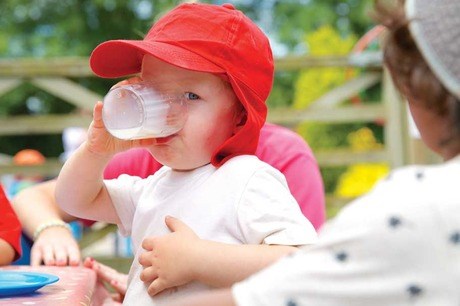Childhood Obesity: Swing into action
Professor Pinki Sahota
Monday, July 14, 2014
Are we getting any closer to understanding childhood obesity? And what should early years practitioners be doing to help prevent it? Professor Pinki Sahota offers expert advice.

Currently within the UK over one third of children of pre-school age are overweight and obese and it is estimated that a tenth (9.5 per cent) of UK children are already obese when they start school (1). Although recent UK data indicate that rates appear to be levelling off in four- and five-year-olds, prevalence remains high, with increased rates amongst low-income and some ethnic groups(1).
Childhood obesity begins in early childhood (2, 3) , with evidence emerging about the impact of obesity on early health. There is evidence of high cholesterol, high blood pressure and abnormal glucose metabolism present in nine-year-olds (4). Furthermore childhood obesity is known to track into adulthood and contribute to obesity-related conditions such as heart disease, diabetes, certain cancers and osteoarthritis (5).
The following factors are known to be associated with an increased risk of childhood obesity:
- maternal obesity(6)
- maternal diabetes
- maternal smoking
- rapid infant growth
- no or short breastfeeding
- obesity in infancy
- short sleep duration,
- less than 30 minutes of daily physical activity
- consumption of sugar-sweetened beverages(7) and
- early introduction of solids (weaning)(8).
Rather than genetics, the shared home environment is emerging as a major contributor to the current childhood obesity epidemic.
It is possible to modify the risk factors related to the home environment and there is consensus amongst childhood obesity experts that prevention of childhood obesity should focus on the early years, so that dietary and physical activity habits, which are normally established at this early age(9, 10) , can be influenced in a positive way.
Parents are ultimately responsible for their child’s development but with many parents in full- or part-time employment, early years practitioners also play an important role by providing opportunities for children to be active and develop healthy eating habits and by acting as positive role models(11).

HEALTHY EATING
Weaning
During infancy, it is recommended that the diet should comprise ideally of breastmilk or formula milk The introduction of solids (weaning) should be delayed until around six months of age because early weaning has been linked with obesity development(5). The aim of weaning is to introduce the infant to a range of textures and flavours from a variety of foods from the following food groups: * fruit and vegetables
- bread, potatoes, pasta and rice
- meat, fish or alternatives such as peas and beans, and
- milk, cheese and yogurt.
The idea too is to familiarise the infant with a range of foods that comprise a healthy diet, so that such foods remain acceptable with increasing age.
Energy-dense foods (cakes, biscuits, savoury snack, crisp-type snacks and confectionary) do constitute part of a healthy diet. However, parent and carers should ensure that these foods are made less available within the home and childcare settings and not offered instead of meals.
There is strong evidence of the link between the intake of sugar-sweetened drinks and excess weight gain in young children(13). Over half of pre-school children drink one or more servings of sweetened drinks per day which contribute 60kcal per day to the diets of two- and three-year-olds(14). With 100 per cent fruit juices also contributing to higher energy intakes, these should be limited to no more than one serving per day (15) and water is recommended as an alternative(16).
Portion sizes
Increased portion sizes are considered to be an important contributing factor to the obesity epidemic, however there is much confusion around appropriate child-size portions. The increase in portion size is particularly evident for energy-dense foods such as snack foods and servings in fast food restaurants.
Educating parents about age-appropriate portion sizes is considered key in promoting healthy eating and alleviating parental anxieties about their child’s intake being insufficient. Recent helpful resources on portion sizes have been produced within the UK by The Infant Toddler Forum (www.infantandtoddlerforum.org) and The Carolyn Walker Trust (www.cwt.org.uk).
Regular meals
A child’s intake can be controlled by establishing a routine and offering meals at set intervals, thereby limiting eating occasions to three meals and two snacks per day.
Ideally, the meals should comprise two courses and, thereby, provide a wide range of nutrients. Pre-school children are often unable to obtain sufficient nutrients for growth and development through three meals and, therefore, need nutritious snacks such as fruit and vegetables, a small sandwich, or breadsticks or crackers with cubes of cheese and celery sticks.
Meal and snack times should be spaced at regular intervals throughout the day in order to prevent feelings of excess hunger and the tendency to over-eat. For more information, see Ten Steps for Healthy Toddlers, available from www.infantandtoddlerforum.org
PROMOTING HEALTHY EATING BEHAVIOURS
Role-modelling
Children learn behaviours through observing others, including taking part in joint activities, therefore parental and carer role modelling presents an ideal opportunity to promote positive behaviours.
Adults should be encouraged to sit with children and eat the same foods, thereby modelling the consumption of healthy foods which in turn encourages children to eat the same foods(17).
It has also been found that families who consistently have family mealtimes are less likely to have overweight children(18). The family approach is also recommended in recent guidance(11) , which emphasises the importance of encouraging all family members to eat healthily and be physically active, regardless of their weight.
Feeding behaviours
Parental feeding strategies such as ‘eat your vegetables and then you can have your dessert’ are shown to be counter-productive and often result in the child having a preference for the restricted food, i.e. the dessert.
Studies indicate that restricting access to foods increased preference for and consumption of those foods when they were no longer restricted. Furthermore, strategies such as ‘eat up’ or ‘clear your plate’ have resulted in increasing a child’s energy intake, increasing the fat content of the child’s diet, reducing intake of fruit and vegetables, increased time that a child spends eating and increasing the degree of child fatness(19).
Responsive feeding
There is clear evidence that young children have the ability to self-regulate (control) their intake, basically they know when they have eaten enough! Although energy intake may vary from meal to meal, intake over a 24-hour period is more consistent(20).
Parent or carer control over all decisions related to children’s food intake, including encouraging the child to eat more even after they have indicated that they are full, or offering larger portions reduces the child’s ability to self-regulate energy intake(21) and can increase the risk of pre-school children becoming overweight (22). Therefore, parents and carers should be encouraged to be responsive to their child’s needs by allowing the child to decide how much they eat based on their awareness for their own hunger and satiety (fullness), which will maintain their ability to self-regulate their energy intake. However parents should be responsible for providing a healthy diet – Parent Provides — Child Decides.
Physical activity and sedentary behaviour
Inactivity in the early years is a key contributor to childhood obesity and impaired physical, cognitive and emotional development. One study found that under-fours spend up to 84 per cent of their waking hours being inactive by sitting in a buggy, being restrained in a car seat or chair or in front of a screen(23).
Guidelines on physical activity published by UK Health Departments(24) make no recommendations about upper limits for sedentary behaviour, stating only that carers should minimise the amount of time under-fives spend this way.
They recommend that pre-school children who are walking should be physically active for three hours a day. As pre-school aged children are unlikely to be able to sustain long periods of activity, several short bursts throughout the day through activities such as playing in the park, walking up stairs, bouncing on a trampoline, dancing, running, walking to nursery are recommended.
10 STEPS TO PREVENTING OBESITY IN PRE-SCHOOL CHILDREN
- Encourage parents and carers to model a healthy lifestyle
- Encourage parents and carers to take a whole family approach
- Encourage responsive feeding
- Reduce availability and accessibility of energy dense food in the home
- Reduce consumption of sweet drinks and increase consumption of water
- Increase acceptance of healthy foods – including fruit and vegetables
- Ensure portion sizes are appropriate for age
- Establish meal routines
- Encourage 180 minutes physical activity per day
- Reduce sedentary activities including screen time to less than one hour per day
Pinki Sahota is professor in nutrition and childhood obesity, School of Health and Wellbeing, Leeds Metropolitan University
REFERENCES
- Health and Social Care Information Centre, Lifestyle Statistics / Department of Health (2012) Health and Social Care Information Centre, Lifestyle Statistics. https://catalogue.ic.nhs.uk/publications/public-health/obesity/nati-chil-meas-prog-eng-2011-2012/nati-chil-meas-prog-eng-2011-2012-rep.pdf [Accessed 30.10.13]
- Baird J, Fisher D, Lucas P, Kleijnen J, Roberts H, Law C (2005). Being big or growing fast: systematic review of size and growth in infancy and later obesity. British Medical Journal 331, 929-931.
- Stettler N, Stallings VA, Troxel AB, Zhao J, Schinnar R, Nelson SE, et al (2005). Weight gain in the first week of life and overweight in adulthood - A cohort study of European American subjects fed infant formula. Circulation 111, 1897-903.
- Gardner DS, Hosking J, Metcalf BS, Jeffery AN, Voss LD, Wilkin TJ. Contribution of early weight gain to childhood overweight and metabolic health: a longitudinal study (EarlyBird 36). Pediatrics. 2009;123 (1):e67-73.
- Oude-Luttikhuis, H., Baur, L., Jansen, H., Shrewsbury, V.A., O’Malley, C., Stolk, R.P. & Summerbell, C.D. (2009) Interventions for treating obesity in children. Cochrane Databases Systematic Review, 21, (1), CD001872.
- Brenda L. Rooney, Michelle A. Mathiason, Charles W. Schauberger (2011) Predictors of Obesity in Childhood, Adolescence, and Adulthood in a Birth Cohort Matern Child Health J (2011) 15:1166–1175
- L. Monasta, G. D. Batty, A. Cattaneo, V. Lutje, L. Ronfani, F. J. van Lenthe and J. Brug (2011) Early-life determinants of overweight and obesity: a review of systematics. Obesity reviews (2010) 11, 695–708
- Sloan S, Gildea A, Stewart M, Sneddon H, Iwaniec D (2007) Early weaning is related to weight and weight gain in infancy. Child: care, health and development. 34, 1, 59-64
- 5. Birch L, Fisher J. Development of eating behaviours among children and adolescents. Pediatrics 1998; 101: 539–549.
- Trost SG, Sirard JR, Dowda M, Pfeiffer KA, Pate RR. Physical activity in overweight and non-overweight preschool children. Int J Obes 2003; 27: 834.
- National Institute for Clinical Excellence (2013) Managing Overweight and Obesity Among Children and Young People: Lifestyle Management Services, NICE: London
- Department of Health (2004): Infant Feeding Recommendation
- Hu, F. B., and V. S. Malik. 2010. Sugar-sweetened beverages and risk of obesity and type 2 diabetes: Epidemiologic evidence. Physiology and Behaviour 100(1):47-54.
- Reedy, J., and S. M. Krebs-Smith. 2010. Dietary sources of energy, solid fats, and added sugars among children and adolescents in the United States. Journal of the American Dietetic Association 110(10):1477-1484.
- Baker, S. S., W. J. Cochran, F. R. Greer, M. B. Heyman, M. S. Jacobson, T. Jaksic, N. F. Krebs, D. Blum-Kemelor, W. Dietz, G. Grave, and S. S. Harris. 2001. The use and misuse of fruit juice in pediatrics. Pediatrics 107(5):1210-1213.
- Wang, Y. C., D. S. Ludwig, K. Sonneville, and S. L. Gortmaker. 2009. Impact of change in sweetened caloric beverage consumption on energy intake among children and adolescents. Archives of Pediatrics and Adolescent Medicine 163(4):336-343.
- Addessi E, Galloway AT, Visalberghi E, Birch LL. 2005. Specific social influences on the acceptance of novel foods in 2-5-year-old children. Appetite. 45(3):264-271.
- Taveras EM, Rifas-Shiman SL, Berkey CS, et al. Family dinner and adolescent overweight. Obesity Research. May 2005;13(5):900-906.
- Birch, L. L. 1999. Development of food preferences. Annual Review of Nutrition 19:41-62.
- Birch, L. L., S. L. Johnson, G. Andresen, J. C. Peters, and M. C. Schulte. 1991. The variability of young children's energy intake. New England Journal of Medicine 324(4):232-238.
- Faith, M. S., K. S. Scanlon, L. L. Birch, L. A. Francis, and B. Sherry. 2004. Parent-child feeding strategies and their relationships to child eating and weight status. Obesity Research 2(11):1711-1722.
- Rhee, K. E., J. C. Lumeng, D. P. Appugliese, N. Kaciroti, and R. H. Bradley. 2006. Parenting styles and overweight status in first grade. Pediatrics (2006) 117(6):2047-2054.
- LeBlanc A et al. Systematic review of sedentary behaviour and health indicators in the early years (aged 0-4 years). Appl Physiol Nutr Metab. 2012; 37:753-772.
- Department of Health. UK physical activity guidelines. London; 2011.










